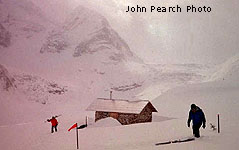 |
Great Cairn Mountaineering TripMarch 19-25, 2000Safety Summary |
Safety Review/Summary
We faced a number of potential dangers and a couple of hazardous situations. Consequences were minimal, and nobody did anything demonstrating a lack of concern for safety.
The main hazards on a trip like this are avalanches and crevasses, and both of these hazards were very much present on this trip. There was a great deal of new snow just before flying in, and more during the week. Everyone on the trip had at least basic avalanche safety training, and there were routes we could follow with minimal exposure to avalanches. We were actually surprised not to witness any significant natural avalanches while we were there.
On our exploration of the Sir Sandford icefall at the end of the week we also encountered crevasse hazards. Fortunately our rescue skills were not put to the test. JD and John had learned the basics in the hut but it would be best for a trip like this to have some thorough training and practice prior to the trip.
A hazard which has become increasingly clear on these trips is that of navigating in flat light. On all of our ski tours we were able to see landmarks in the distance for navigation on a larger scale, but we couldn't always see what lay directly ahead. Our experiences at the end of our tour to Palisade Pass on Monday illustrated the dangers involved. JD fell into a small hole in the midst of a visible cluster of exposed rocks which we could see. The next cluster of rocks was an outcropping on a cliff band where consequences could have been more serious. The previous year at Fairy Meadows I had fallen through a small cornice above a small slope, and somebody else in another group had done the same thing. It is best to avoid traveling in the alpine when you can't clearly see where you are going and don't have solid first-hand experiential knowledge of the area. If it is necessary then it is best to use the utmost caution, which typically means very slow travel. There isn't too much to do about this hazard except to avoid it by not traveling in these conditions or by making sure you know the area you are in quite well.
This flat light and low visibility has been very common for the past two years in March. In 2001 I plan to go to a destination that has more variety of treed and alpine terrain so that fun and safe options will exist in any weather. (Postscript - That trip was to Blanket Glacier, reports available from the main trips page. It was, once again, cloudy with flat light. But there are many good skiing options in the trees there as long as you don't let the helicopter skiing trafffic nearby and even overhead get to you. In 2002 we went to Fairy Meadows in early April and had excellent weather with cold clear days during which most tours were possible.)
- Jim
|
[Main Great Cairn 2000 Page] [Main Organized Trips Page] |
Guiding page
|